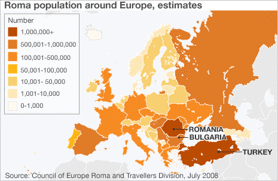The situation of the Roma population in Europe[editar]
The Roma/gitanos are the largest minority within the existing European Union (EU). Today, despite the fact that this population arrived in Europe centuries ago, they continue to be marked by severe discrimination, social rejection, and a state of general exclusion.
Who are the European Roma/gitanos?
Following the recommendations of the Council of Europe, the consensus within the international community is that the term “Roma” covers the different groups and subgroups of gitanos in Europe such as Roma, Traveller, and Sinti.
Although there are no official figures, it is estimated that there are around ten million European citizens of Roma origin, making this the largest minority in the EU. The highest concentration is in Central and Western European countries: Romania (with over 2 million), Bulgaria (some 700,000), Hungary (over 500,000), the Czech Republic (some 300,000), and Slovakia (almost 450,000). These countries are all existing members of the EU.

What is their situation?
Despite the fact that the Roma population arrived in Europe centuries ago, today, they continue to be marked by severe discrimination, social rejection, and a state of general exclusion. A large number of Roma families find themselves in a serious situation of poverty and marginalisation, particularly in Central and Western European countries:
- In the field of education, most Roma only attend the obligatory stage of teaching, and many do not even complete this stage. In some countries, it is normal to have schools or classrooms for those with mental disabilities, which in most cases, are Roma-only. Moreover, the level of illiteracy in the adult population is very high.
- With regard to vocational training and employment, the lack of vocational training, together with rejection and social prejudices, means that many Roma do not have a job, and they live solely off social benefits. In certain parts of countries such as Hungary, Slovakia, or Romania where there is a high concentration of Roma, unemployment rates among the Roma reach 90% of the population. Moreover, the Roma do not engage in other types of activities that would contribute to their livelihood.
- Housing is probably one of the most pressing problems facing these populations. Many live in ghettos and segregated settlements, in which there is sometimes not even any running water. This is especially true of Slovakia, where there are over 500 settlements of this kind. In other cases, they live in urban areas but in blocks where only Roma families live, and generally in abysmal conditions.
- With regard to health, it is well-known that the average life expectancy of the Roma population is around ten years less than the rest of the population, not to mention the higher rates of morbidity, deformity, and disability.
What is the current context?
This difficult situation has forced many Eastern European groups to emigrate to the West in search of a better standard of living, or simply as a way of avoiding persecution and harassment. In many cases, this migratory phenomenon has led to a conflict with host societies such as Italy or France. This has led to the commissioning of political and police measures that are far removed from the social integration of this community and have received plenty of media coverage throughout the whole of Europe, subsequently triggering off an activation of social inclusion measures at EU level.
The demographic weight of the Roma population, but above all, the state of social exclusion and general rejection from the majority societies, justifies the relevance that this subject has had in recent years and continues to have in the European political agenda. The enlargement of the EU towards the East (2004 and 2007) have marked a turning point in the consideration of the Roma issue within the framework of European institutions and other international bodies, and, by extension, in national political agendas.
The EU framework is without a doubt a favourable context for the development of the Roma minority in terms of citizenship with its necessary instruments and policies. But it requires a significant and sustained boost in order to improve the effectiveness and implementation of all the policies. Many initiatives, programmes, and projects are being developed; many resources are being spent in promoting and driving the inclusion of the Roma population, though not always in an efficient manner and with suitable approaches.
Many European countries and European institutions are looking to Spain and the FSG as a reference for working with the Roma population, for the inclusive model that has developed in recent decades, and for the methodological approaches that are being applied.







